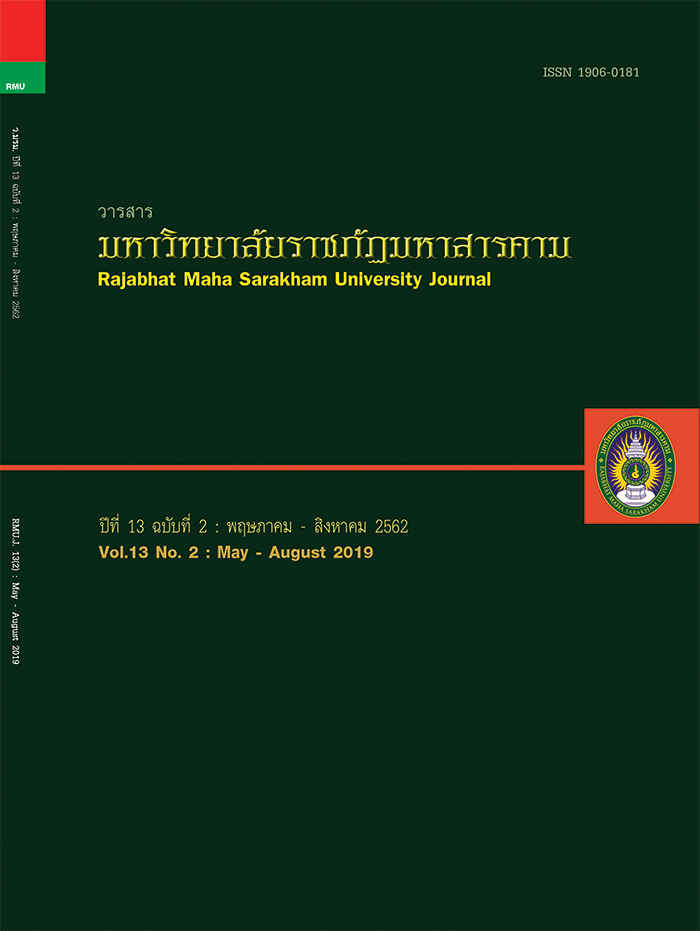บทเรียนบนเว็บแบบซินเนคติกส์ร่วมกับเทคนิคเพื่อนช่วยเพื่อน ที่ส่งเสริมความคิดสร้างสรรค์ สำหรับนักเรียนชั้นมัธยมศึกษาปีที่ 3
Main Article Content
บทคัดย่อ
การวิจัยในครั้งนี้มีวัตถุประสงค์ (1) เพื่อพัฒนาบทเรียนบนเว็บแบบซินเนคติกส์ร่วมกับเทคนิคเพื่อนช่วยเพื่อน ที่
ส่งเสริมความคิดสร้างสรรค์ สำหรับนักเรียนชั้นมัธยมศึกษาปีที่ 3 ที่มีประสิทธิภาพตามแกนเมกุยแกน (2) เพื่อเปรียบเทียบผลสัมฤทธิ์ และความคิดสร้างสรรค์ ของนักเรียนที่เรียนด้วยบทเรียนบนเว็บที่พัฒนาขึ้น หลังเรียนสูงกว่าก่อนเรียนและ (3) เพื่อศึกษาความพึงพอใจของนักเรียนที่มีต่อการเรียนด้วยบทเรียนบนเว็บตามกระบวนการสอนแบบซินเนคติกส์ร่วมกับเทคนิคเพื่อนช่วยเพื่อนที่ส่งเสริมความคิดสร้างสรรค์ กลุ่มตัวอย่างที่ใช้เป็นนักเรียนชั้นมัธยมศึกษาปีที่ ปีการศึกษา 2559 โรงเรียนศิลาทองพิทยาสรรค์ จังหวัดยโสธร จำนวน 3 ห้อง จำนวนผู้เรียนทั้งหมด 25 คน คัดเลือกมาเป็นกลุ่มตัวอย่าง โดยวิธีสุ่มแบบกลุ่ม (Cluster Random Sampling) เครื่องมือที่ใช้ในการวิจัยประกอบด้วย 1) บทเรียนบนเว็บแบบซินเนคติกส์ร่วมกับเทคนิคเพื่อนช่วยเพื่อนที่ส่งเสริมความคิดสร้างสรรค์ 2) แบบทดสอบวัดผลสัมฤทธิ์ทางการเรียน 3) แบบทดสอบความคิดสร้างสรรค์ 4) แบบวัดความพึงพอใจของผู้เรียนสถิติที่ใช้ในการวิจัย ได้แก่ ค่าเฉลี่ย ร้อยละ ส่วนเบี่ยงเบนมาตรฐาน ทดสอบสมติฐานด้วย t-test
ผลการวิจัยพบว่า (1) บทเรียนบนเว็บแบบซินเนคติกส์ร่วมกับเทคนิคเพื่อนช่วยที่ส่งเสริมความคิดสร้างสรรค์ที่พัฒนาขึ้น ประกอบด้วย ขั้นตอนการสอนแบบซินเนคติกส์6 ขั้นตอน ได้แก่ ขั้นนำ, ขั้นเปรียบเทียบทางตรง, ขั้นเปรียบเทียบกับตนเอง, ขั้นสร้างและอธิบายคำที่มีความหมายขัดแย้งกัน, ขั้นเปรียบเทียบทางตรงครั้งที่ 2 และขั้นนำความคิดใหม่มาสร้างสรรค์งาน ร่วมกับเทคนิคเพื่อนช่วยเพื่อนได้แก่ ขั้นฝึกอบรม,ขั้นจับคู่ผู้เรียน,ขั้นฝึกปฏิบัติ,ขั้นหาคู่และทีมชนะ และขั้นทดสอบ ทำให้บทเรียนบนเว็บที่พัฒนาขึ้นมีคุณภาพอยู่ในระดับมากและมีประสิทธิภาพเท่ากับ 1.23 ซึ่งมากกว่าเกณฑ์มาตรฐานเมกุยแกนส์ (2) นักเรียนที่เรียนด้วยบทเรียนที่พัฒนาขึ้น มีผลสัมฤทธิ์ทางการเรียนและความคิดสร้างสรรค์ หลังเรียนสูงกว่าก่อนเรียน อย่างมีนัยสำคัญทางสถิติที่ระดับ .01 และ (3) นักเรียนมีความพึงพอใจต่อการเรียนด้วยบทเรียนบนเว็บที่พัฒนาขึ้นอยู่ในระดับดี
Article Details
1. บทความที่ลงตีพิมพ์ทุกเรื่องได้รับการตรวจทางวิชาการโดยผู้ประเมินอิสระ ผู้ทรงคุณวุฒิ (Peer Review) สาขาที่เกี่ยวข้อง อย่างน้อย 3 ท่าน ในรูปแบบ Double blind review
2. ข้อคิดเห็นใด ๆ ของบทความที่ลงตีพิมพ์ในวารสารมหาวิทยาลัยราชภัฏมหาสารคาม นี้เป็นของผู้เขียน คณะผู้จัดทำวารสารไม่จำเป็นต้องเห็นด้วย
3. กองบรรณาธิการวารสารมหาวิทยาลัยราชภัฏมหาสารคาม ไม่สงวนสิทธิ์การคัดลอกแต่ให้อ้างอิงแสดงที่มา
เอกสารอ้างอิง
Ministry of Education.(2008). Basic Education Core Curriculum 2008. Bangkok : Agricultural Cooperatives of Thailand.
Office of the National Economic and Social Development Board. (2011). National Economic and Social Development Plan No. 11 (2012-2016).Bangkok : Prime Minister’s Office.
Wittayakorn Chiengkul. (2011). Thailand Education Report Year 2004/2005 “The root of problems and solutions”. Bangkok : VT Chi Communication Limited Partnership.
Aree Rungsimun. (1989). Creativity. Bangkok :Millet Printing.
Tasanee Kaemanee.(2013). Teaching Science :Knowledge for effective learning process management. 17th edition. Bangkok : Chulalongkorn University.
Palita Buasidam. (2009).“The Effects of Using Big Six Skills Web-based Courseware Entitled Introduction of Information and Computer on Learning Achievement and Problem-Solving Skills by Using Information of Prathomsueksa 5 Students”. Journal of Education, Mahasarakrm university, 3 (3) ; 32-38.
Caserta-Henry, C. (1996). Reading buddies A first grade intervention program. The Reading Teacher, 49, 500- 503.
Monchai Thientong. (2011). Design and Development of Computer Lessons. 3rd edition. Bangkok : King Mongkut’s Institute of TechnologyNorth Bangkok.
Saranya Chuathong. (2010). Research and Development of a Virtual Classroom Using Collaborative Learning and Synectics Instruction to Develop Creative Thinking of Undergraduate Students Majored in Education,and Related Field. Doctor of Philosophy Thesis : Chulalongkorn University.
Teacher Training. (1979). Research report on the creativity of Thai children in kindergarten -Primary 4. Supervisory Unit : SuanSunandha Printing Factory.
Somnuek Patthiyathanee.(2003). Educational Measurement. 4 th edition. Kalasin : Prasarn Printing.
LuanSaiyod and Aungkana Saiyod. (1995). Educational research techniques. 4 th edition.Bangkok : Suweeriyasarn Printing.
Saowanee Sikkhabhandit. (1985). Educational technology. Bangkok : King Mongkut’s Institute of Technology North Bangkok.
Bunchom Srisaard.(2002). Preliminary Research. 7th edition. Bangkok : Suweeriyasarn Printing.
Tasanee Kaemanee. (2005). Teaching Science: Knowledge for effective learning process management.Bangkok : Chulalongkorn University.
Chaiyod Ruengsuwan.(2010). The Lesson program and Web-based lessons Development Design. 15th edition.Mahasarakham : Mahasarakham University.
Sutthikan Tipayakeson. (2002). Development MathayomSuksa 3 Students’ Creativity Through the Synectics Method. Chiang Mai : Chiang Mai University.
Sukon Sinthapanon and Others. (2002). Management of student-centered learning processes is important in accordance with the basic education curriculum. Bangkok : Aksornchareonthad.
Suwit & Orathai Moonkam.(2002). 21 Ways to Learn to Develop Thinking Processes. Bangkok : Duangkamonsamai.
Panita Yana. (2012). Use of Synectic Techniques to develop the advertising writing ability in printed media of MathayomSuksa 3 students. Master of Education : Chiang Mai University.
Ruengdech Nongsae. (2012). Using of synectics instructional model to develop creative writing ability of vocational education certificate students.Master of Education : Chiang Mai University.


